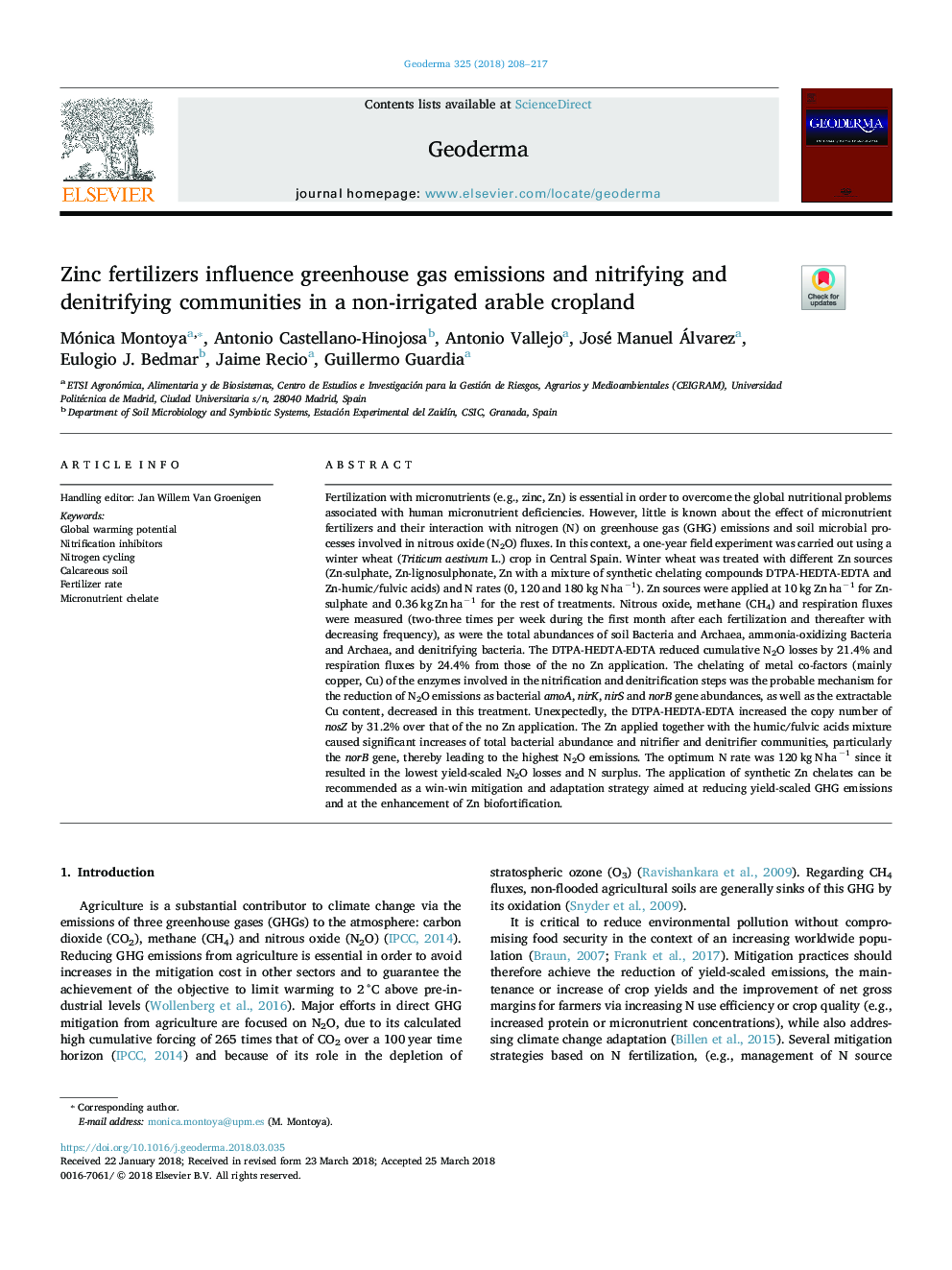| کد مقاله | کد نشریه | سال انتشار | مقاله انگلیسی | نسخه تمام متن |
|---|---|---|---|---|
| 8894014 | 1629392 | 2018 | 10 صفحه PDF | دانلود رایگان |
عنوان انگلیسی مقاله ISI
Zinc fertilizers influence greenhouse gas emissions and nitrifying and denitrifying communities in a non-irrigated arable cropland
ترجمه فارسی عنوان
کودهای روی بر گازهای گلخانه ای و جوامع نیتروژن و نیتروژن زدایی تاثیر می گذارند در یک نهال زراعت آبیاری غیر
دانلود مقاله + سفارش ترجمه
دانلود مقاله ISI انگلیسی
رایگان برای ایرانیان
کلمات کلیدی
موضوعات مرتبط
مهندسی و علوم پایه
علوم زمین و سیارات
فرآیندهای سطح زمین
چکیده انگلیسی
Fertilization with micronutrients (e.g., zinc, Zn) is essential in order to overcome the global nutritional problems associated with human micronutrient deficiencies. However, little is known about the effect of micronutrient fertilizers and their interaction with nitrogen (N) on greenhouse gas (GHG) emissions and soil microbial processes involved in nitrous oxide (N2O) fluxes. In this context, a one-year field experiment was carried out using a winter wheat (Triticum aestivum L.) crop in Central Spain. Winter wheat was treated with different Zn sources (Zn-sulphate, Zn-lignosulphonate, Zn with a mixture of synthetic chelating compounds DTPA-HEDTA-EDTA and Zn-humic/fulvic acids) and N rates (0, 120 and 180â¯kgâ¯Nâ¯haâ1). Zn sources were applied at 10â¯kgâ¯Znâ¯haâ1 for Zn-sulphate and 0.36â¯kgâ¯Znâ¯haâ1 for the rest of treatments. Nitrous oxide, methane (CH4) and respiration fluxes were measured (two-three times per week during the first month after each fertilization and thereafter with decreasing frequency), as were the total abundances of soil Bacteria and Archaea, ammonia-oxidizing Bacteria and Archaea, and denitrifying bacteria. The DTPA-HEDTA-EDTA reduced cumulative N2O losses by 21.4% and respiration fluxes by 24.4% from those of the no Zn application. The chelating of metal co-factors (mainly copper, Cu) of the enzymes involved in the nitrification and denitrification steps was the probable mechanism for the reduction of N2O emissions as bacterial amoA, nirK, nirS and norB gene abundances, as well as the extractable Cu content, decreased in this treatment. Unexpectedly, the DTPA-HEDTA-EDTA increased the copy number of nosZ by 31.2% over that of the no Zn application. The Zn applied together with the humic/fulvic acids mixture caused significant increases of total bacterial abundance and nitrifier and denitrifier communities, particularly the norB gene, thereby leading to the highest N2O emissions. The optimum N rate was 120â¯kgâ¯Nâ¯haâ1 since it resulted in the lowest yield-scaled N2O losses and N surplus. The application of synthetic Zn chelates can be recommended as a win-win mitigation and adaptation strategy aimed at reducing yield-scaled GHG emissions and at the enhancement of Zn biofortification.
ناشر
Database: Elsevier - ScienceDirect (ساینس دایرکت)
Journal: Geoderma - Volume 325, 1 September 2018, Pages 208-217
Journal: Geoderma - Volume 325, 1 September 2018, Pages 208-217
نویسندگان
Mónica Montoya, Antonio Castellano-Hinojosa, Antonio Vallejo, José Manuel Álvarez, Eulogio J. Bedmar, Jaime Recio, Guillermo Guardia,
